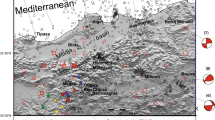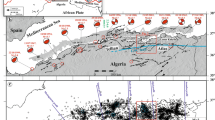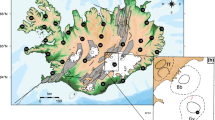Abstract
The Lorca 2011 seismic series was recorded by an unprecedented set of high quality on scale broadband seismograms and strong motion accelerograms. The waveforms from permanent and temporary broadband seismic networks deployed in the region by different institutions allowed to invert regional moment tensor for the fore, main and largest aftershock of the complete seismic sequence. Using double-difference algorithm we have performed a precise relocation of the seismic series, where body wave travel times from strong ground motion accelerograms were included in the data set. Regional moment tensor inversion for the three main events show similar oblique-reverse faulting regime with a northeast-southwest fault orientation. The scalar seismic moment, moment magnitude and focal depth retrieved from the inversion yield the following values for each event: \(\hbox {Mo}=6.5\times 10^{16}\) Nm (Mw = 5.2) for the mainshock, \(\hbox {Mo}= 9.6 \times 10^{15}\) Nm (Mw = 4.6) for the foreshock and \(\hbox {Mo}=7.3\times 10^{14}\) Nm (Mw = 3.9) for the large aftershock. The centroid depths range between 4 and 6 km. The double-difference relocation of the seismic series shows significant epicentral differences with the preliminary routine location. The epicentral solutions given by this relocation show a seismic sequence distributed following a NE–SW strike, subparallel to the Alhama de Murcia fault and compatible with the faulting parameters inverted from the moment tensor analysis. The hypocenters of the series generate a subvertical trend in depth distribution, being concentrated between 2 and 6 km. The depth distribution of the main events, which range from 4.6 to 5.5 km, is in good relationship with the faulting and depth parameters deduced from the moment tensor inversion technique. The regional moment tensor solutions for the three largest earthquakes, the epicentral distribution and the focal depths show good relationship with the surface geometry and tectonic regime of the Alhama de Murcia fault. The stress drop deduced for the mainshock gives a value ranging between 58 and 85 bars, which does not support the idea of a high stress drop release as a main factor contributing to the high ground acceleration recorded at Lorca. The PGA values observed at Lorca, which contributed to the high damage independently of structural deficiencies, could be generated mainly by shallowness and proximity to the seismic source together with a directivity effect in the seismic radiation.












Similar content being viewed by others
References
Benito B, Capote B, Murphy P, Gaspar-Escribano JM, Martínez-Díaz JM, Tsige M, Stich D, García-Mayordomo J, García-Rodríguez MJ, Jiménez-Peña ME, Insua-Arévalo JM, Álvarez-Gómez JA, Canora C (2007) An overview of the damaging and low magnitude Mw 4.8 La Paca earthquake on 29 January 2005: context, seismotectonics, and seismic risk implications for Southeast Spain. Bull Seismol Soc Am 97:671–690
Bratt SR, Bache TC (1988) Locating events with sparse network of regional arrays. Bull Seism Soc Am 78:780–797
Brune JN (1970) Tectonic stress and the spectra of the seismic shear waves from earthquakes. J Geophys Res 75:4997–5009
Buforn E, Sanz de Galdeano C (2001) Focal mechanism of Mula (Murcia, Spain) earthquake of February 2, 1999. J Seism 5:277–280
Buforn E, Benito B, Sanz de Galdeano C, del Fresno C, Muñoz D, Rodríguez I (2005) Study of the damaging earthquakes of 1911, 1999, and 2002 in the Murcia, Southeastern Spain, region: seismotectonic and seismic-risk implications. Bull Seism Soc Am 95:549–567
Buland R, Chapman C (1983) The computation of seismic travel times. Bull Seism Soc Am 73:1271–1302
García-Mayordomo J, Insua-Arévalo JM, Martínez-Díaz JJ, Jiménez-Díaz A, Martín-Banda R, Martín-Alfageme S, Álvarez-Gómez JA, Rodríguez-Peces M, Pérez-López R, Rodríguez-Pascua MA, Masana E, Perea H, Martín-González F, Giner-Robles J, Nemser ES, Cabral J, QAFI Compilers (2012) The quaternary active faults database of Iberia (QAFI v. 2.0). J Iber Geol 38(1):285–302
Hanks TC, Kanamori H (1979) A moment magnitude scale. J Geophys Res 84(9):2348–2350
Instituto Geográfica Nacional (IGN) (2011) Informe del sismo de Lorca del 11 de mayo de 2011. Avaialble at http://www.ign.es/ign/layoutIn/sismologiaPublicacionesBoletinesSismicos.do
Jordan TH, Sverdrup KA (1981) Teleseismic location techniques and their application to earthquake clusters in the Soth-Central Pacific. Bull Seism Soc Am 71:1105–1130
Langston CA, Barker JS, Pavlin GB (1982) Point-source inversion techniques. Phys Earth Planet Inter 30:228–241
López-Comino JA, Mancilla F, Morales J, Stich D (2012) Rupture directivity of the 2011, Mw 5.2 Lorca earthquake (Spain). Geophys Res Lett 39:L03301. doi:10.1029/2011GL050498
Mancilla F, Ammon CJ, Herrmann RB, Morales J (2002) Faulting parameters of the 1999 Mula earthqueake, southeastern Spain. Tectonophysics 354:139–155
Martínez Guevara JB, Fernández Navarro-Soto S (1986) Catálogo sísmico de la región de Murcia. (Sismicidad histórica hasta el siglo XVIII). Instituto Geográfico Nacional (in spanish).
Martínez Solares JMM, Mezcua J (2002) Catálogo sísmico de la Península Ibérica (880 a.C.–1900). Dirección General del Instituto Geográfico Nacional (in spanish). 256 pp
Martinez-Diaz JJ (2002) Stress field variety related to fault interaction in a reverse oblique-slip fault: the Alhama de Murcia fault, Betic Cordillera, Spain. Tectonophysics 356:291–305. doi:10.1016/S0040-1951(02)00400-6
Masana E, Martínez-Díaz JJ, Hernández-Henrile JL, Santanach P (2004) The Alhama de Murcia fault (SE Spain), a seismogenic fault in a diffuse plate boundary: implications for the Ibero-Magrebian region. J Geophys Res 109:B01301. doi:10.029/2002JB002359
Mezcua J, Martinez Solares JM (1983) Sismicidad del área Iberomogrebi. Instituto Geográfico Nacional (in spanish).
Mezcua J, Herraiz M, Buforn E (1984) Study of the 6 June 1977 Lorca (Spain) earthquake and its aftershock sequence. Bull Seism Soc Am 74:167–179
Nagy W (1996) New region-dependent travel-time handling facilities at the IDC: functionality, testing and implementation details. Technical Report SAIC-96/1179, 57 pp.
Ocaña E, Stich D, Carmona E, Vidal F, Bretón M, Navarro M, García-Jeréz A (2008) Spatial analysis of the La Paca, SE Spain seismic series through the relative location of multiplets and principal component analysis. Phys. Earth Planet Int 166:117–127
Rey Pastor A (1949) La comarca sísmica de Caravaca y el sismo de 23 junio 1948. Instituto Geográfico y Catastral (in spanish).
Rueda J, Mezcua J, García-Blanco RM (2011) Directivity effects of the May 11, 2011 Lorca (Spain) Mw = 5.1 earthquake. In: Fall meeting, AGU, San Francisco, Communications. S53B–2277.
Stich D, Ammon CJ, Morales J (2003) Moment tensor solutions for small and moderate earthquakes in the Ibero-Maghreb region. J Geophys Res 108(B3):2148. doi:10.1029/2002JB002057
Stich D, Mancilla F, Baumont D, Morales J (2005) Source analysis of the Mw 6.3 2004 Al Hoceima earthquake (Morocco) using regional apparent source time functions. J Geophys Res 110:B06306. doi:10.1029/2004JB003366
Stich D, Martín R, Morales J (2010) Moment tensor inversión for Iberia-Maghreb earthquakes 2005–2008. Tectonophysics 483:390–398
Stich D, Serpelloni E, Mancilla F, Morales J (2006) Kinematics of the Iberia-Maghreb plate contact from seismic moment tensors and GPS observations. Tectonophysics 426:295–317
Utsu T (2002) Statistical features of seismicity. In: Lee WHK, Kanamori H, Jennings PC, Kisslinger C (eds) International handbook of earthquake and engineering seismology part A. Academic Press, San Diego, pp 719–732
Vissers RLM, Meijninger BML (2011) The 11 May 2011 earthquake at Lorca (SE Spain) viewed in a structural-tectonic context. Solid Earth Discuss 3:527–540
Waldhauser F (2001) HypoDD: a computer program to compute double-difference earthquake locations. U.S. Geol. Surv. Open File Rep., 01–113.
Waldhauser F, Ellsworth W (2000) Double-difference earthquake location algorithm: method and application to the northern Hayward fault, California. Bull Seism Soc Am 90:1353–1368
Weichert DH (1980) Estimation of the earthquake recurrence parameters for unequal observation periods for different magnitudes. Bull Seismol Soc Am 70(4):1338–1346
Wiemer S (2001) A Software package to analyze seismicity: ZMAP. Seism Res Lett 72:373–382
Acknowledgments
We are grateful to University of Alicante (AFON), ROA/UCM/Geofon (CART) and CRAAG (OKGL) for providing high quality seismic data from their stations. We are also grateful to José F. Valero for his help on the figures and to Luis Cabañas for the valuable discussion about the b value computation. The authors thank to two anonymous referees for their careful revisions of the manuscript and their contributions to improve this work. We received financial support through Spanish National Projects CGL2008-01830, TOPO-IBERIA (CSD2006- 00041) and Junta de Andalucía Project P09-RNM-5100.
Author information
Authors and Affiliations
Corresponding author
Rights and permissions
About this article
Cite this article
Morales, J., Cantavella, J.V., de Lis Mancilla, F. et al. The 2011 Lorca seismic series: Temporal evolution, faulting parameters and hypocentral relocation. Bull Earthquake Eng 12, 1871–1888 (2014). https://doi.org/10.1007/s10518-013-9476-x
Received:
Accepted:
Published:
Issue Date:
DOI: https://doi.org/10.1007/s10518-013-9476-x




